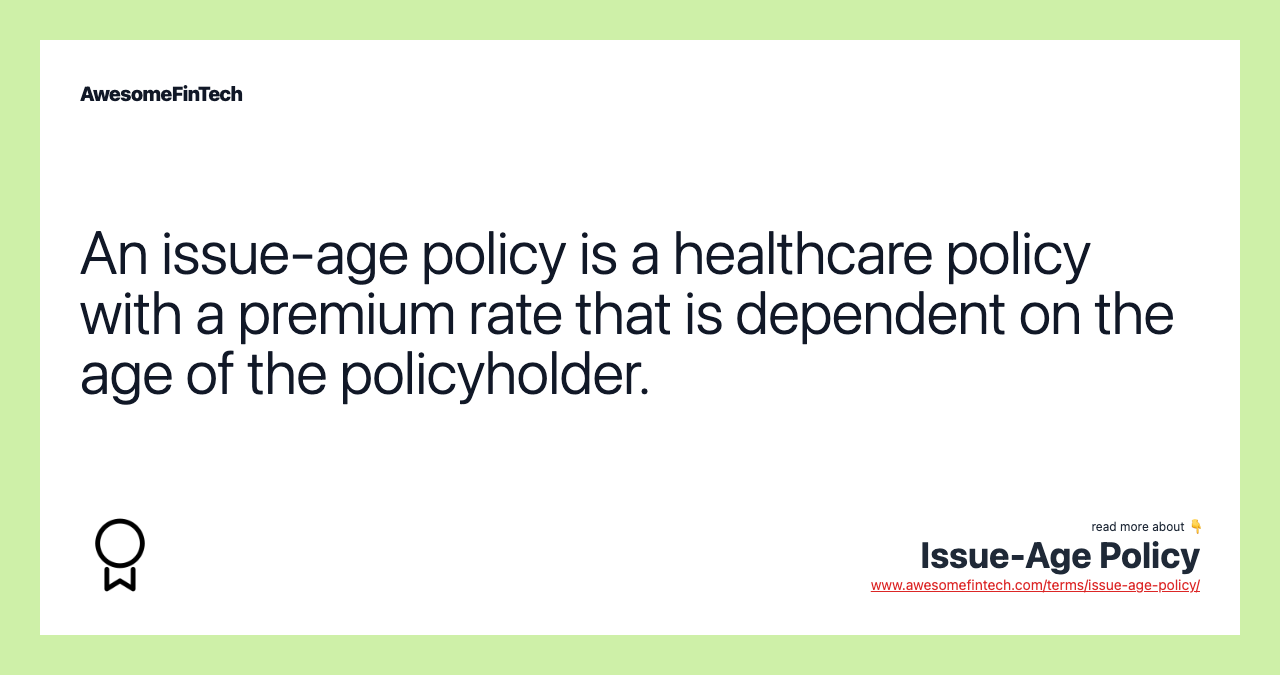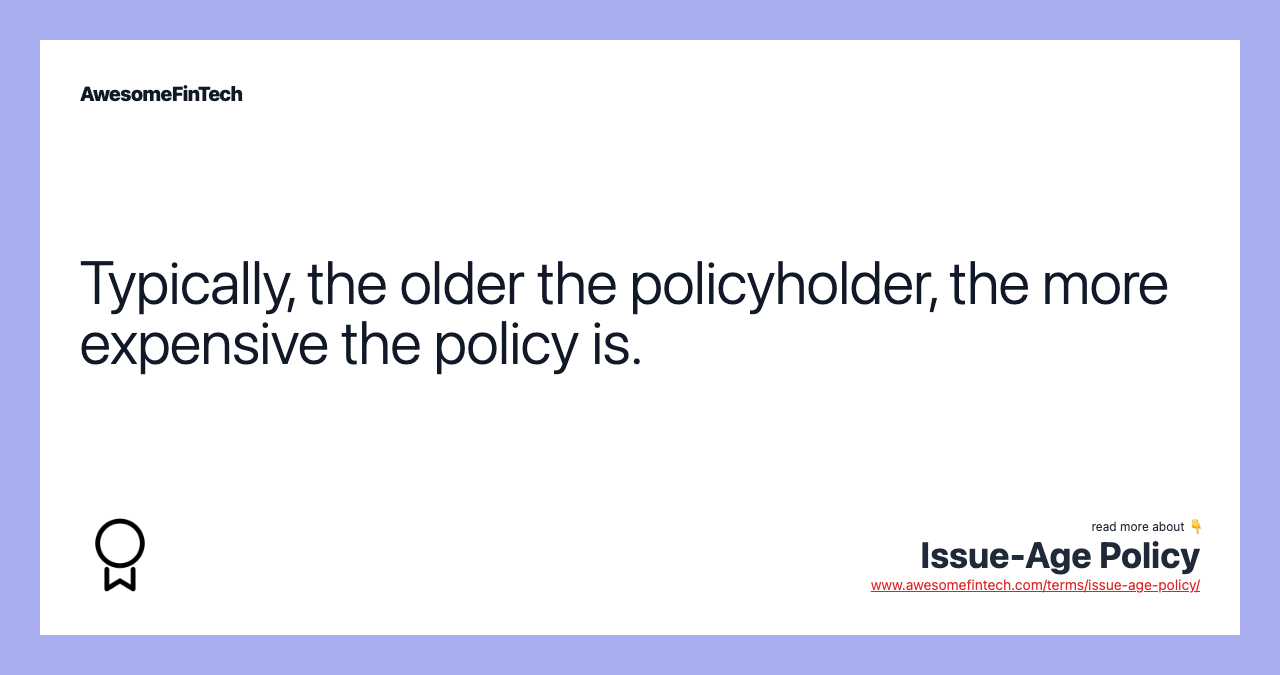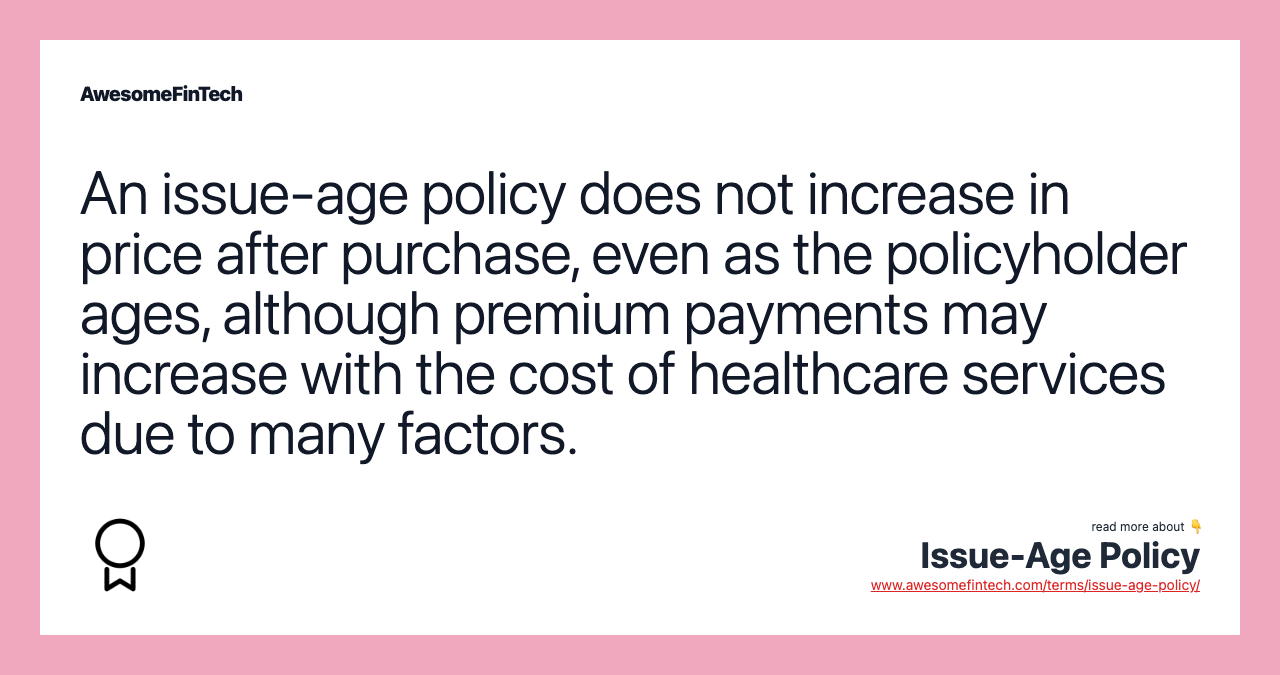Issue-Age Policy
An issue-age policy is a healthcare policy that has a premium rate that is dependent on the age of the individual who purchases it. Insurance providers who underwrite issue-age policies will tie the cost of the policy to an individual's age because, statistically, older policyholders are more likely to require medical treatment. An issue-age policy does not increase in price after purchase, even as the policyholder ages, although premium payments may increase with the cost of healthcare services due to many factors. An issue-age policy is a healthcare policy that has a premium rate that is dependent on the age of the individual who purchases it. An issue-age policy is a healthcare policy with a premium rate that is dependent on the age of the policyholder.

What Is an Issue-Age Policy?
An issue-age policy is a healthcare policy that has a premium rate that is dependent on the age of the individual who purchases it. Issue-age pricing frequently comes into play when pricing Medigap policies. These policies are more expensive for older individuals than for younger policyholders.
Once bought, the issue-age policy does not increase in price any further based on age. However, premium payments typically increase as the cost of healthcare services rises due to many factors. Many companies that offer Medicare Supplementary Medical Insurance (SMI) — also known as Medigap insurance — will use issue-age as one of the pricing models for the contracts they sell.



How an Issue-Age Policy Works
Insurance providers who underwrite issue-age policies will tie the cost of the policy to an individual's age because, statistically, older policyholders are more likely to require medical treatment.
All healthcare premiums will increase over time. Some of these cost increases are due to inflation and the ever-rising price of providing medical care. Others may point at regulatory changes and the end of insurance subsidies on both a state and national level as the culprit.
Also, in some cases, a state may have only a limited number of providers wishing to underwrite insurance within their borders. This limitation will increase the risk to the providers because they cover a more substantial group of customers. Even the number of policies underwritten for lower-income individuals may increase the price of all policies a provider holds. Insurance providers continually update the profiles of the average claim risk they expect to experience by region and by age.
Because the United States, on the whole, is aging, the cost of caring for the total population will continue to increase. Medical underwriting will continue to play a role in setting premium prices. This system assesses the risk linked with providing health insurance coverage to an individual. The examination and analysis of medical information help the provider determine risk and set the premium.
Special Considerations
Pricing Models for Yearly Premiums
However, another factor that may raise a policyholder's annual premium has a basis on the pricing method in use when the policy originated. Healthcare insurance providers use the following three primary pricing models when quoting yearly premiums for individual policies. Chosen deductibles and copay levels will also impact the premium regardless of the pricing method in use. Buyers must be aware of which system is in use as they compare insurance quotes from competing providers.
Issue-Age Method
The issue-age method sets pricing dependent on a person's age at the time of the policy's underwriting and issuance. Premiums only increased if the insurance provider rises all policies in the given state across the board. Issue-age pricing tends to be less expensive than other pricing methods. Younger policyholders will see the most benefit from issue-age policies if they expect to hold them for many years.
Attained-Age Premiums
Attained-age premiums begin like issue-age premiums — based on the individual's age at issuance. However, these premiums will increase as the policyholder ages. On average, this increase is about 1.5% per year, but some policies may see much higher premium increases due to health issues as well as the number of candles on their birthday cake.
Community-Rated Pricings
Community-rated pricing has a base premium, priced equally for everyone in the area with equal policy deductibles and copays, irrespective of age. The premium will not increase due to the age, gender, occupation, or medical underwriting history of the policyholder. However, it will increase with the across-the-board changes the provider experiences. Community-rating tends to be more expensive when policies begin but will balance out over time. In some situations, the beginning premium may be up to three times higher than an issue-age or attained-age premium.
Employee or group insurance plans may also use experience-rating as a pricing method. The provider will review the group's claim history to predict if the group's future medical cost may increase.
Medigap and Issue-Age Policies
The American Association of Retired Persons (AARP) offered suggestions for those shopping for a Medigap policy. One tip is to take a close look at your annual healthcare spending, each year and, "as best you can, think about what our future health costs may be and list these also."
Another recommendation, of course, is to take time to shop around to various insurance companies and find out what sort of premiums they might charge.
"One reason for the wide range in price is the pricing or rating method the insurance company uses. While a policy may cost less when you first buy it, it may cost you more in the long run because of the rating method used," according to AARP. "You might want to look for community-rated and issue-age-rated policies. They might be the best buy because, even though these policies might cost you more at age 65, they'll cost you less as you get older."
Related terms:
Attained Age
Attained age is the age at which the beneficiary of an insurance policy, retirement plan or other aged-dependent plan, can get benefits or withdraw funds. read more
Copay
A copay is a fixed amount paid by an insured for covered services. Insurance providers often charge co-pays for services such as doctor visits or prescription drugs. read more
Experience Rating (Insurance)
In the field of insurance, an experience rating is the amount of loss that an insured party experiences compared to the amount of loss that similar insured parties experience. read more
Health Insurance
Health insurance is a type of insurance coverage that pays for medical and surgical expenses that are incurred by the insured. read more
Insurance Inflation Protection
Insurance inflation protection is designed to allow policyholders to make sure that the benefits they receive can keep up with the inflation rate. read more
Insurance Premium
An insurance premium is the amount of money an individual or business pays for an insurance policy. read more
Lapse
A lapse is the cessation of a privilege, right, or policy due to time or inaction. Learn how a lapse impacts contracts, insurance, and stock shares. read more
Life Insurance Guide to Policies and Companies
Life insurance is a contract in which an insurer, in exchange for a premium, guarantees payment to an insured’s beneficiaries when the insured dies. read more
Medical Underwriting
Medical underwriting is the process of assessing the risk of providing health insurance coverage to an individual and setting the price accordingly. read more